2018 MERCEDES-BENZ S-CLASS SEDAN oil
[x] Cancel search: oilPage 438 of 562
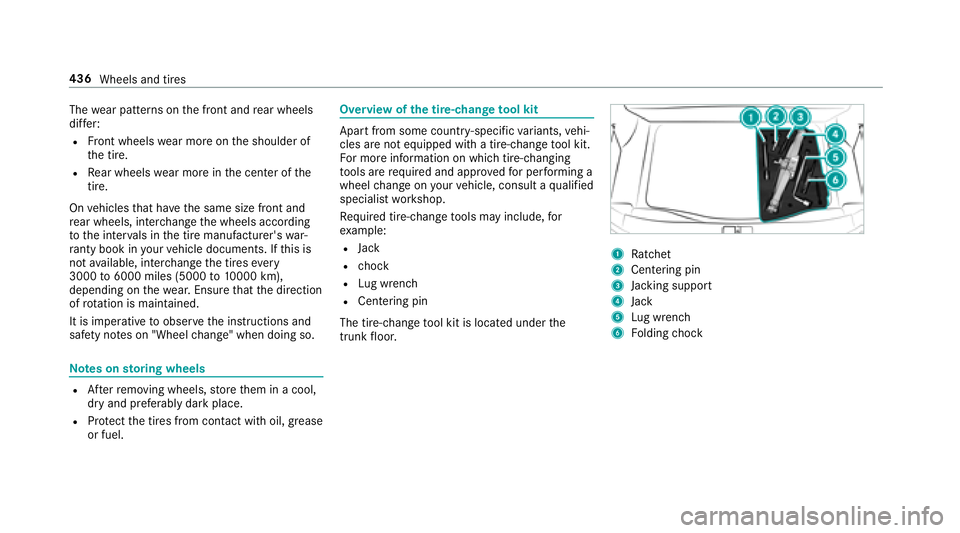
Thewear patte rns on the front and rear wheels
dif fer:
RFr ont wheels wear more on the shoulder of
th e tire.
RRe ar wheels wear more in the center of the
tire.
On vehicles that ha vethe same size front and
re ar wheels, inter change the wheels according
to the inter vals in the tire manufacturer's war‐
ra nty book in your vehicle documents. If this is
not available, inter change the tires every
3000 to6000 miles (5000 to10000 km),
depending on thewe ar. Ensure that the direction
of rotation is maintained.
It is impe rative toobser vethe instructions and
saf etyno tes on "Wheel change" when doing so.
Note s onstoring wheels
RAf terre moving wheels, store them in a cool,
dry and preferably dark place.
RPr otect the tires from conta ct withoil, grease
or fuel.
Overview of the tire-chan getool kit
Apart from some countr y-specific variants, vehi‐
cles are not equipped with a tire-change tool kit.
Fo r more information on which tire-changing
to ols are required and appr oved for per form ing a
wheel change on your vehicle, consult a qualified
specialist workshop.
Re quired tire-change tools may include, for
ex ample:
RJack
Rch ock
RLu g wrench
RCentering pin
The tire-change tool kit is located under the
trunk floor.
1Ra tchet
2Centering pin
3Jack ing support
4Jack
5Lu g wrench
6Fo lding chock
436
Wheels and tires
Page 443 of 562
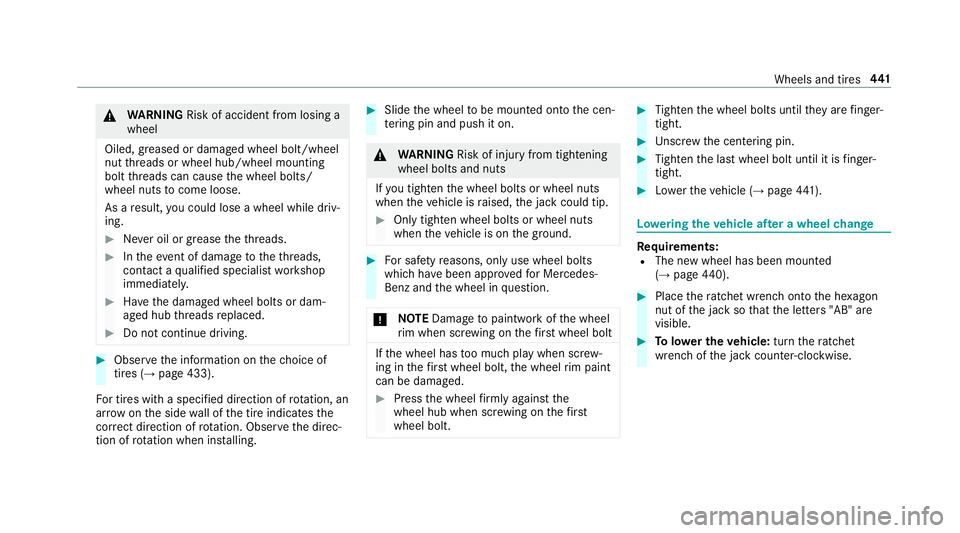
&WARNING Risk of accident from losing a
wheel
Oiled, greased or damaged wheel bolt/wheel
nut thre ads or wheel hub/wheel mounting
bolt thre ads can cause the wheel bolts/
wheel nuts tocome loose.
As a result, you could lose a wheel while driv‐
ing.
#Ne ver oil or grease theth re ads.
#In theeve nt of damage totheth re ads,
con tact a qualified specialist workshop
immediatel y.
#Have the damaged wheel bolts or dam‐
aged hub thre ads replaced.
#Do not continue driving.
#Obser vethe information on thech oice of
tires (→page 433).
Fo r tires with a specified direction of rotation, an
ar row onthe side wall of the tire indicates the
cor rect dire ction of rotation. Observ eth e direc‐
tion of rotation when ins talling.
#Slide the wheel tobe mounted onto the cen‐
te ring pin and push it on.
&
WARNING Risk of injury from tightening
wheel bolts and nuts
If yo u tighten the wheel bolts or wheel nuts
when theve hicle is raised, the jack could tip.
#Only tighten wheel bolts or wheel nuts
when theve hicle is on the ground.
#Fo r saf etyre asons, only use wheel bolts
which ha vebeen appr ovedfo r Mercedes-
Benz and the wheel in question.
* NO
TEDama getopaintwork of the wheel
ri m when scr ewing on thefirs t wheel bolt
If th e wheel has too much play when scr ew‐
ing in thefirs t wheel bolt, the wheel rim paint
can be dama ged.
#Press the wheel firm lyagainst the
wheel hub when scr ewing on thefirs t
wheel bolt.
#Ti ghten the wheel bolts until they are finger-
tight.
#Un scr ew the centering pin.
#Tighten the last wheel bolt until it is finger-
tight.
#Lo we rth eve hicle (→page 441).
Lo weri ngtheve hicle af ter a wheel change
Re quirements:RThe new wheel has been mounted
(→page 440).
#Plac eth era tchet wrench onto the he xagon
nut of the jack so that the letters "AB" are
visible.
#To lowe r the vehicle: turnthera tchet
wrench of the jack counter-clockwise.
Wheels and tires 44
1
Page 451 of 562
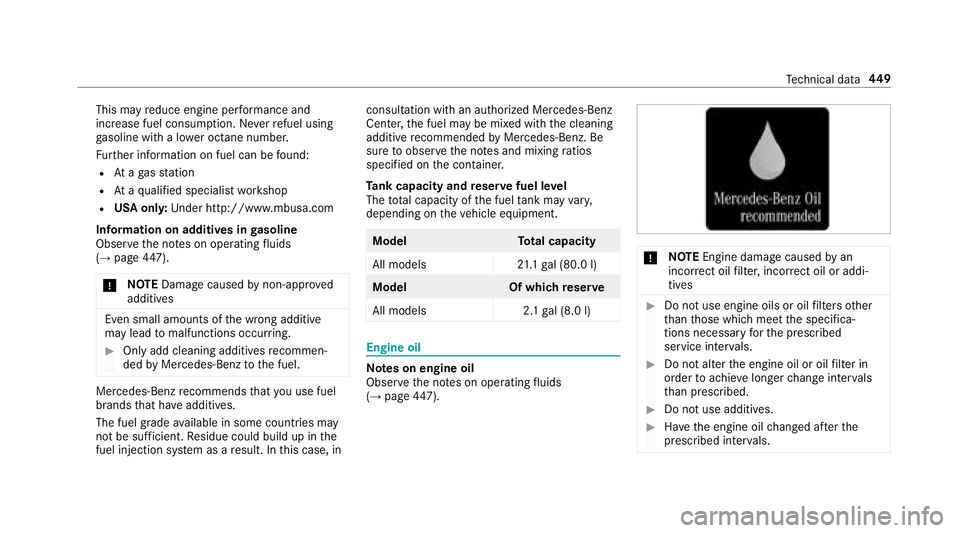
This mayreduce engine per form ance and
inc rease fuel consum ption. Ne verre fuel using
ga soline with a lo wer octane number.
Fu rther information on fuel can be found:
RAt aga sst ation
RAt aqu alified specialist workshop
RUSA onl y:Un der http://www.mbusa.com
Information on additives in gasoline
Obser vethe no tes on operating fluids
(
→page 447).
* NO
TEDama gecaused bynon-app rove d
additives
Even small amounts of the wrong additive
may lead tomalfunctions occur ring.
#Only add cleaning additives recommen‐
ded byMercedes-Benz tothe fuel.
Mercedes-Benz recommends that you use fuel
br ands that ha veadditives.
The fuel grade available in some countries may
not be suf ficient. Residue could build up in the
fuel injection sy stem as a result. In this case, in consultation with an authorized Mercedes-Benz
Center,
the fuel may be mixed with the cleaning
additive recommended byMercedes-Benz. Be
sure toobser vethe no tes and mixing ratios
speci fied on the conta iner.
Ta nk capacity and reser vefuel le vel
The total capacity of the fuel tank may vary,
depending on theve hicle equipment.
Model Total capacity
Al lmodels 21.1ga l(8 0.0 l)
Model Of whichreser ve
All model s2 .1ga l (8.0 l)
Engine oil
Note s on engine oil
Obser vethe no tes on operating fluids
(
→page 447).
* NO
TEEngine damage causedbyan
incor rect oil filter, incor rect oil or addi‐
tives
#Do not use engine oils or oil filters other
th an those which meet the specifica‐
tions necessary forth e prescribed
service inter vals.
#Do not alter the engine oil or oil filter in
order toachie velonger change inter vals
th an prescri bed.
#Do not use additives.
#Have the engine oil changed af terth e
prescribed inter vals.
Tech nical da ta44
9
Page 452 of 562
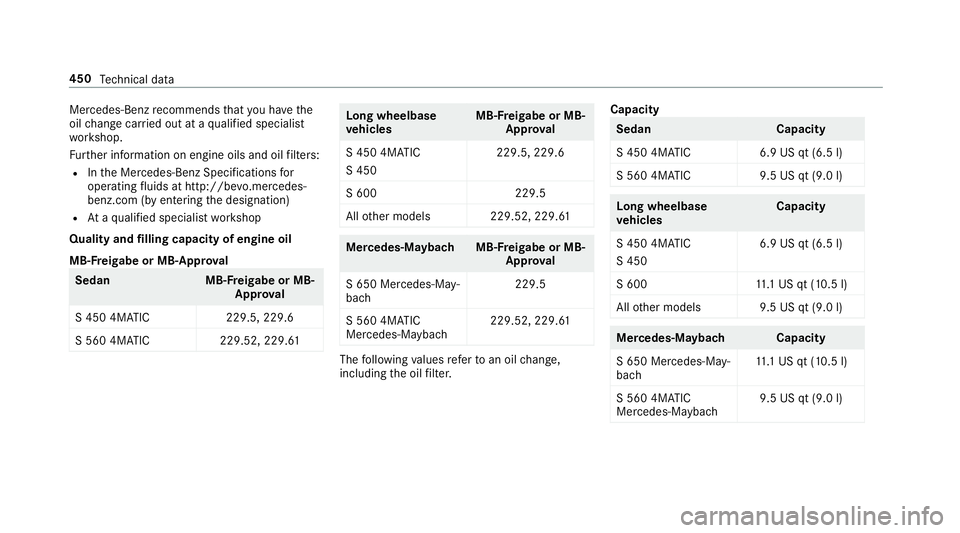
Mercedes-Benzrecommends that you ha vethe
oil change car ried out at a qualified specialist
wo rkshop.
Fu rther information on engine oils and oil filters:
RIn the Mercedes-Benz Specifications for
operating fluids at http:/ /bevo.mercedes-
benz.com (byen tering the designation)
RAt aqu alified specialist workshop
Quality and filling capacity of engine oil
MB- Freigabe or MB-A pproval
Sedan MB-Freigabe or MB-
Appr oval
S 450 4MATIC 229.5, 229.6
S 560 4MATIC 229.52, 229.61
Long wheelbase
vehicles MB-F
reigabe or MB-
Appr oval
S 450 4MATIC
S 450 229.5, 229.6
S 600 229.5
All other models 229.52, 229.61
Mercedes‑Maybac hMB-Freigabe or MB-
Appr oval
S 650 Mercedes-May‐
bach 229.5
S 560 4MATIC
Mercedes-Mayba ch229.52, 229.61
The
following values referto an oil change,
including the oil filter. Capacity
Seda
nC apacity
S 450 4MATIC 6.9 US qt (6.5 l)
S 560 4MATIC 9.5 US qt (9.0 l)
Long wheelbase
vehicles Capacity
S 450 4MATIC
S 450 6.9 US qt (6.5 l)
S 600 11.1 US qt (10.5 l)
All other models 9.5 US qt (9.0 l)
Mercedes‑Maybac hCapacity
S 650 Mercedes-May‐
bach 11
.1 US qt (10.5 l)
S 560 4MATIC
Mercedes-Maybach 9.5 US qt (9.0 l)
450
Tech nical da ta
Page 453 of 562

Notes on brake fluid
Obser vethe no tes on operating fluids
(→page 447).
&
WARNING Risk of an accident due to
va por poc kets form ing in the brake sys‐
te m
The brake fluid cons tantly absorbs moist ure
from the air. This lo wersthe boiling point of
th e brake fluid. If the boiling point is too lo w,
va por poc kets may form inthe brake sy stem
when the brakes are applied hard.
This causes the braking ef fect to be
impaired.
#Ha ve the brake fluid rene we d at the
specified inter vals.
Ha ve the brake fluid regularly changed at a quali‐
fi ed specialist workshop.
Only use brake fluid appr ovedby Mercedes-Benz
according toMB-F reigabe or MB-Appr oval 33 1.0. Fu
rther information on brake fluid:
RIn the Mercedes-Benz Specifications for
Operating Fluids at http://be vo.mercedes-
benz.com
RAt aqu alified specialist workshop
Coolant
Note s on coolant
Obser vethe no tes on operating fluids
(
→page 447).
&
WARNING ‑ Risk of fire and injury from
antifreeze
If antifreeze comes into contact with hot
component parts in the engine compart‐
ment, it may ignite.
#Allow the engine tocool down before
adding antifreeze.
#Make surethat no antifreeze spills out
next tothefiller opening.
#Thoroughly clean off any antifreeze
from component parts before starting
th eve hicle.
* NO
TEDama gecaused byincor rect cool‐
ant
#Only add coolant that has been pre‐
mixed with therequ ired antifreeze pro‐
te ction.
Fu rther information on coolant:
RIn the Mercedes-Benz Specifications for
Operating Fluids 310.1, e.g. online at
http://be vo.mercedes-benz.com.
RAt aqu alified specialist workshop.
* NO
TEOverheating at high outside tem‐
peratures
If an inappro priate coolant is used, the
engine cooling sy stem is not suf ficiently pro‐
te cted against overheating and cor rosion at
high outside temp eratures.
Tech nical da ta451
Page 455 of 562
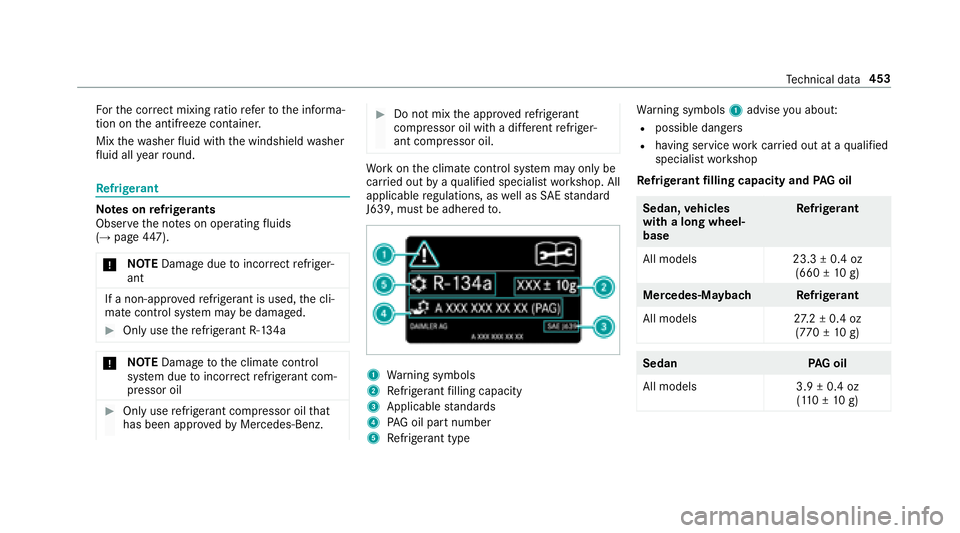
Forth e cor rect mixing ratio referto the informa‐
tion on the antif reeze conta iner.
Mix thewa sher fluid withth e windshield washer
fl uid all year round.
Re frigerant
Note s onrefrigerants
Obser vethe no tes on operating fluids
(
→page 447).
* NO
TEDama gedue toincor rect refriger‐
ant
If a non-appr ovedre frigerant is used, the cli‐
mate control sy stem may be damaged.
#Only use there frigerant R‑134a
* NO
TEDama getothe climate control
sy stem due toincor rect refrigerant com‐
pressor oil
#Only use refrigerant compressor oil that
has been appr ovedby Mercedes-Benz.
#Do not mix the appr ovedre frigerant
compressor oil with a dif fere nt refriger‐
ant compressor oil.
Wo rkon the climate control sy stem may only be
car ried out byaqu alified specialist workshop. All
applicable regulations, as well as SAEstandard
J639, must be adhered to.
1Wa rning symbols
2Re frigerant filling capacity
3Applicable standards
4PA G oil part number
5Re frigerant type Wa
rning symbols 1advise you about:
Rpossible dangers
Rhaving service workcar ried out at a qualified
specialist workshop
Re frigerant filling capacity and PAG oil
Sedan, vehicles
with a long wheel‐
base Re
frigerant
All models2 3.3 ± 0.4 oz
(660 ± 10g)
Mercedes‑Maybac hRefrigerant
All models2 7.2 ± 0.4 oz
(770 ± 10g)
Sedan PAG oil
All models3 .9 ± 0.4 oz
(1 10 ±10 g)
Tech nical da ta453
Page 456 of 562
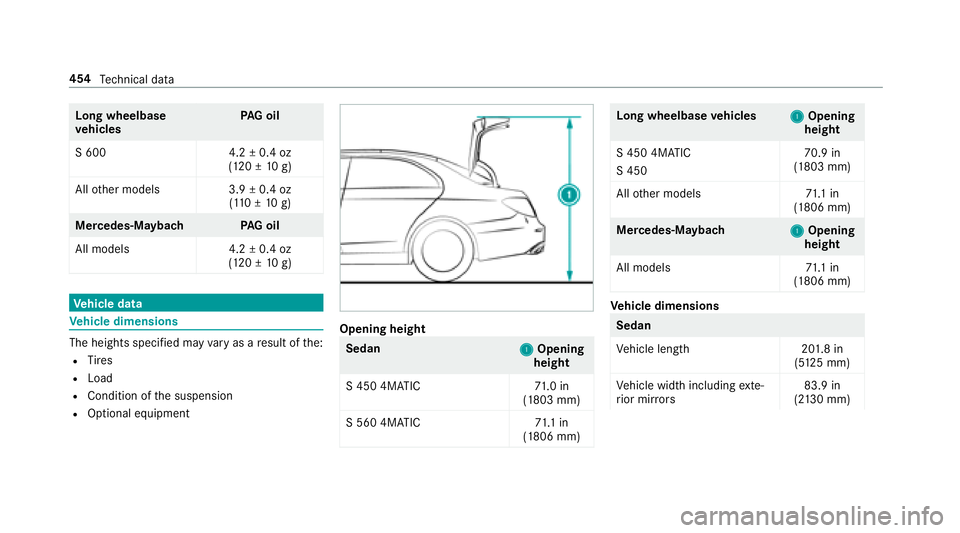
Long wheelbase
vehicles PA
G oil
S 600 4.2 ± 0.4 oz
(120 ± 10g)
All other models 3.9 ± 0.4 oz
(1 10 ±10 g)
Mercedes‑Maybac hPAGoil
All models 4.2 ± 0.4 oz
(120 ± 10g)
Vehicle data
Vehicle dimensions
The heights specifi ed mayvary as a result of the:
RTire s
RLoad
RCondition of the suspension
ROptional equipment
Opening height
Sedan
1Opening
height
S 450 4MATIC 71.0 in
(1803 mm)
S 560 4MATIC 71.1in
(1806 mm)
Long wheelbase vehicles
1Opening
height
S 450 4MATIC
S 450 70.9 in
(1803 mm)
All other models 71.1in
(1806 mm)
Mercedes‑M aybach
1Opening
height
All models 71.1in
(1806 mm)
Ve hicle dimensions
Sedan
Vehicle lengt h2 01.8 in
(5 12 5 mm)
Ve hicle width including exte‐
ri or mir rors 83.9 in
(2 13 0 mm)
454
Tech nical da ta
Page 471 of 562
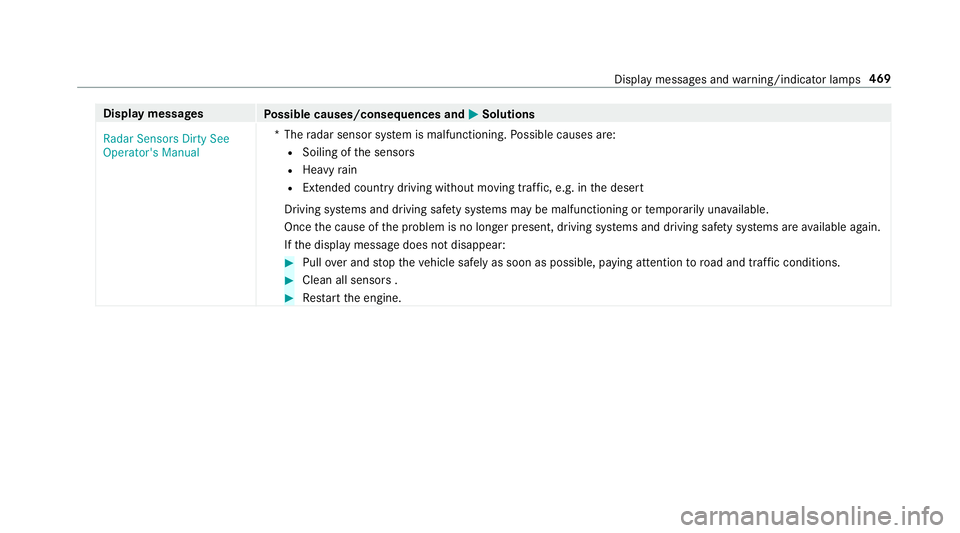
Displaymessages
Possible causes/consequences and MSolutions
�5�D�G�D�U �6�H�Q�V�R�U�V �'�L�U�W�\ �6�H�H
�2�S�H�U�D�W�R�U�
�V �0�D�Q�X�D�O *T
heradar sensor sy stem is malfunctioning. Possible causes are:
RSoiling of the sensors
RHeavy rain
REx tended country driving wi thout moving traf fic, e.g. in the desert
Driving sy stems and driving saf etysy stems may be malfunctioning or temp orarily una vailable.
Once the cause of the problem is no longer present, driving sy stems and driving saf etysy stems are available again.
If th e display message does not disappear:
#Pull over and stop theve hicle safely as soon as possible, paying attention toroad and traf fic conditions.
#Clean all sensors .
#Restart the engine.
Display messages and warning/indicator lamps 469